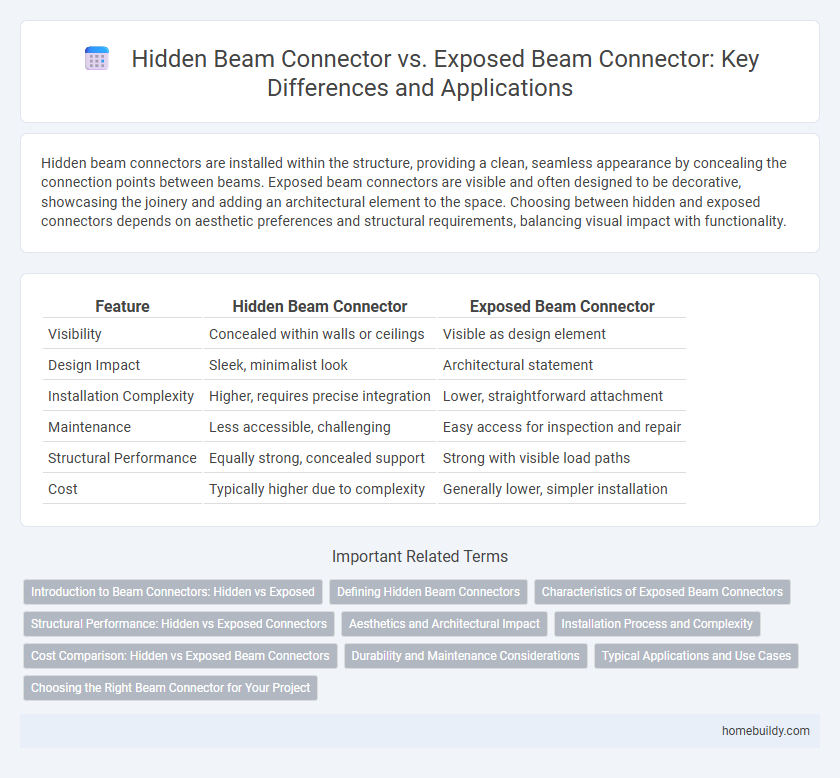Hidden beam connectors are installed within the structure, providing a clean, seamless appearance by concealing the connection points between beams. Exposed beam connectors are visible and often designed to be decorative, showcasing the joinery and adding an architectural element to the space. Choosing between hidden and exposed connectors depends on aesthetic preferences and structural requirements, balancing visual impact with functionality.
Table of Comparison
| Feature | Hidden Beam Connector | Exposed Beam Connector |
|---|---|---|
| Visibility | Concealed within walls or ceilings | Visible as design element |
| Design Impact | Sleek, minimalist look | Architectural statement |
| Installation Complexity | Higher, requires precise integration | Lower, straightforward attachment |
| Maintenance | Less accessible, challenging | Easy access for inspection and repair |
| Structural Performance | Equally strong, concealed support | Strong with visible load paths |
| Cost | Typically higher due to complexity | Generally lower, simpler installation |
Introduction to Beam Connectors: Hidden vs Exposed
Hidden beam connectors provide a seamless aesthetic by being embedded within structural elements, enhancing architectural design without visible hardware. Exposed beam connectors, often crafted from steel or metal, emphasize structural integrity and industrial appeal through visible joints and fasteners. Choosing between hidden and exposed connectors depends on design priorities, structural requirements, and maintenance considerations.
Defining Hidden Beam Connectors
Hidden beam connectors are structural components designed to join beams seamlessly without visible hardware, enhancing aesthetic appeal and maintaining clean architectural lines. These connectors are embedded within the beam or concealed by surrounding materials, providing strong load transfer while preserving design integrity. Compared to exposed beam connectors, hidden options prioritize unobtrusive installation and often require precise engineering to ensure both strength and invisibility.
Characteristics of Exposed Beam Connectors
Exposed beam connectors are designed to be visible, often showcasing intricate metalwork or architectural details that enhance the aesthetic appeal of a structure. These connectors are typically made from durable materials such as steel or wrought iron, ensuring strong load-bearing capacity and resistance to environmental factors. Their accessibility allows for easier inspection and maintenance compared to hidden beam connectors, which contributes to long-term structural integrity.
Structural Performance: Hidden vs Exposed Connectors
Hidden beam connectors provide superior protection against environmental corrosion and mechanical damage, enhancing the long-term structural performance of beams. Exposed beam connectors, while easier to inspect and maintain, may experience accelerated wear due to direct exposure to weather elements and physical impacts. Structural engineers often prefer hidden connectors for critical load-bearing applications where durability and aesthetic integration are priorities.
Aesthetics and Architectural Impact
Hidden beam connectors offer a sleek, minimalist aesthetic by seamlessly integrating into the structure, preserving clean lines and enhancing architectural elegance. Exposed beam connectors contribute a distinctive industrial or rustic character, showcasing structural elements as design features that add visual interest and texture. The choice between hidden and exposed connectors significantly shapes the spatial ambiance and influences the overall architectural expression of a building.
Installation Process and Complexity
Hidden beam connectors require precise alignment and skilled labor for installation due to their concealed nature, often involving embedded components within the beam structure. Exposed beam connectors are generally easier to install as they are visible and accessible, allowing for straightforward fastening and inspection. The complexity of hidden connectors increases installation time and demands higher accuracy compared to the simpler, more flexible installation process of exposed connectors.
Cost Comparison: Hidden vs Exposed Beam Connectors
Hidden beam connectors typically incur higher installation costs due to the need for precise alignment and specialized labor, increasing overall project expenses. Exposed beam connectors are generally more cost-effective, benefiting from straightforward installation and reduced labor time. Material costs may vary, but the savings in labor and installation efficiency make exposed connectors a more budget-friendly option in most construction projects.
Durability and Maintenance Considerations
Hidden beam connectors offer enhanced protection against environmental factors, reducing corrosion and wear, which significantly improves durability. Exposed beam connectors require regular inspection and maintenance to prevent rust and structural degradation due to direct exposure to moisture and pollutants. Choosing hidden connectors minimizes maintenance frequency and prolongs the lifespan of the beam connection in both indoor and outdoor applications.
Typical Applications and Use Cases
Hidden beam connectors are typically used in architectural designs where aesthetics and clean lines are essential, such as in modern residential homes, commercial interiors, and high-end timber framing projects. Exposed beam connectors are common in rustic or industrial settings, including barns, warehouses, and outdoor structures, where structural elements are intended to be visible for design emphasis or ease of maintenance. Both types find use in heavy timber construction, but hidden connectors provide seamless integration, while exposed connectors offer structural clarity and ease of inspection.
Choosing the Right Beam Connector for Your Project
Selecting the right beam connector depends on structural requirements and aesthetic preferences, with hidden beam connectors offering a clean, seamless appearance ideal for modern designs. Exposed beam connectors provide visible hardware that can enhance industrial or rustic styles while allowing easier inspections and adjustments. Evaluating load capacity, ease of installation, and design integration ensures optimal performance and visual harmony in your construction project.
hidden beam connector vs exposed beam connector Infographic

 homebuildy.com
homebuildy.com